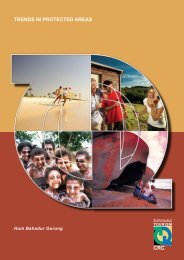icolls - Sustainable Tourism CRC
icolls - Sustainable Tourism CRC
icolls - Sustainable Tourism CRC
Create successful ePaper yourself
Turn your PDF publications into a flip-book with our unique Google optimized e-Paper software.
ECOLOGY, THREATS AND MANAGEMENT OPTIONS FOR SMALL ESTUARIES AND ICOLLS<br />
Sampling Methods<br />
The relative proportion of naturally occurring carbon and nitrogen isotopes have been used to describe feeding<br />
relationships and the relative importance of different carbon sources to aquatic food webs for the past 20 years<br />
(Kitting, Fry & Morgan 1984; Peterson & Fry 1987; France 1995; Post 2002). This method has been particularly<br />
useful in discriminating the relative importance of carbon sources from terrestrial, freshwater and marine<br />
sources, as the carbon isotope signatures for these different environments are generally distinct (Peterson 1999;<br />
Post 2002). In these instances, mixing models have been developed to quantitatively ascertain the role of the<br />
dominant carbon sources to consumer diets (Post 2002).<br />
In all ICOLLs, samples for stable isotope analyses of food web structure were collected at least once between<br />
January and May 2003 and November 2004. In order to get a handle on variability within ICOLLs, samples were<br />
collected from more than one site, depending on the geomorphology of the ICOLL and logistical constraints. An<br />
effort was made to collect samples from marine-, estuarine- and freshwater-dominated sites within each system<br />
wherever possible. Samples for stable isotope analyses involved collection of all sources of organic matter likely<br />
to support consumers at each sampling site, including sediment, detritus, algae and terrestrial vegetation.<br />
Invertebrate and vertebrate consumers were also collected, to enable construction of food webs on the basis of<br />
biota and food sources from each sample site.<br />
The primary sources of carbon sampled at all sites were riparian vegetation, mangroves, BFPOM(BFPOM),<br />
BCPOM (BCPOM), attached algae and epilithon, seston (phytoplankton + suspended organic matter) and<br />
macrophytes. Macrophytes, riparian vegetation and mangroves were collected by hand, while BFPOM and<br />
BCPOM samples were collected by sifting benthic sediments through a series of graded sieves (250 µm – 500<br />
µm – 1 cm). BFPOM samples were obtained from the 250 µm sieve and BCPOM samples were collected from<br />
the 500 µm sieve.<br />
Attached algae and epilithon were carefully scraped from surfaces, including mangrove pneumatophores,<br />
rocks and woody debris using a scalpel blade and brush. Seston (phytoplankton, zooplankton and suspended<br />
organic matter) were collected using a 65 µm plankton tow net. Freshwater aquatic insects, crustaceans and<br />
small fish were collected using either a dip net or a small purse seine net. Fish were also collected in a larger<br />
seine net. Sediment-dwelling organisms, including bivalve molluscs, marine yabbies and bloodworms were<br />
collected using a yabby pump. Mobile consumers, including crabs, were opportunistically collected by hand<br />
whenever possible.<br />
Upon collection, all samples were immediately placed in individually labeled zip-lock bags and stored on ice.<br />
For animals, this approach has been shown to enable them time to void their guts, thereby expediting their<br />
processing in the laboratory (Bunn & Boon 1993; Beaudoin, Prepas, Tonn, Wassenaar & Kotak 2001; Hadwen<br />
& Bunn 2005). Samples were frozen for transportation back to the laboratory.<br />
Laboratory Sample Processing<br />
In the laboratory, samples of riparian vegetation, BFPOM, BCPOM, attached algae/epilithon, macrophytes and<br />
mangroves were rinsed with distilled water to wash away dirt and debris. All samples were dried in an oven at<br />
60°C for at least 48 hours. Dried samples were pulverised in a puck and ring grinding mill for approximately 3<br />
minutes, or until the sample had been reduced to a fine powder. Ground samples were subsequently stored in 5<br />
ml vials and frozen prior to analysis.<br />
Trichopteran larvae were removed from their cases upon collection. All aquatic macroinvertebrates were<br />
rinsed and dried before being ground using a mortar and pestle. Individuals were ground whole, but ground<br />
individuals were often subsequently pooled to ensure sample size was sufficient to enable isotopic analyses.<br />
The exoskeletons of all aquatic crustaceans were removed to ensure that accumulated calcium carbonate did<br />
not influence carbon isotopic values (Mihuc & Toetz 1994; Leggett, Servos, Hesslein, Johannsson, Millard &<br />
Dixon 1999; Beaudoin et al. 2001). For zooplankton, samples were split in two, with half acid washed in 10%<br />
HCl to remove exoskeletons and the remainder processed as normal for accurate quantification of nitrogen<br />
isotope signatures (Bunn, Loneragan & Kempster 1995).<br />
17











